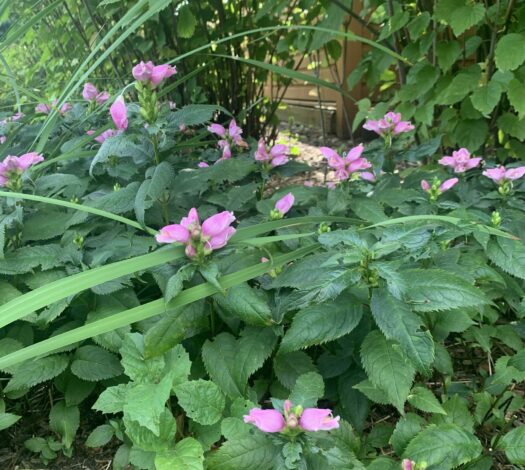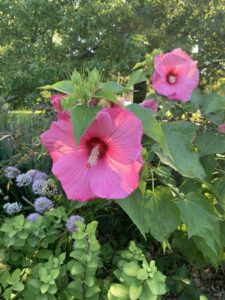Fall-Blooming Perennial Questions Answered

Great gardens are colorful throughout the growing season. Many perennials can be grown in Iowa to provide flowers and interest year after year in late summer and fall. In this article, horticulturists with Iowa State University Extension and Outreach offer advice on selecting and planting great perennials with late-season bloom.
What are some good perennials that bloom in late summer and fall?
Perennials for full sun locations that bloom well in Iowa late in the growing season include pincushion flower (Scabiosa species), calamint (Calamintha nepeta), balloon flower (Platycodon species), Russian sage (Perovskia atriplicifolia), windflower (Anemone × hybrida), New York aster (Symphyotrichum novi-belgii), showy stonecrop (Hylotelephium species), and goldenrod (Solidago hybrids).
Several perennials native to Iowa that bloom late in the season include black-eyed Susan (Rudbeckia hirta), rattlesnake master (Eryngium yuccifolium), false sunflower (Heliopsis helianthoides), vervain (Verbena stricta), gray-headed coneflower (Ratibida species), sneezeweed (Helenium autumnale), and boltonia (Boltonia asteroides).
For areas with wet soils, Iowa native perennials to try include Joe-Pye weed (Eutrochium purpureum), ironweed (Vernonia fasciculata), mountain mint (Pycnanthemum virginianum), obedient plant (Physostegia virginiana), and Culver’s root (Veronicastrum virginicum). Other perennials such as hardy hibiscus (Hibiscus species) and pink turtlehead (Chelone lyonii) also bloom late in the growing season.
Finally, several ornamental grasses develop their most attractive features in late summer and fall. These perennials have seed heads that mature, and leaves that develop fall color, in autumn. These grasses include Japanese silver grass (Miscanthus sinensis cultivars) and plume grass (Saccharum ravennae, formerly Erianthus ravennae), as well as natives such as Indian grass (Sorghastrum nutans), northern sea oats (Chasmanthium latifolium), switchgrass (Panicum virgatum), and little bluestem (Schizachyrium scoparium).
What shade perennials bloom in late summer and fall?
Perennials such as corydalis (Pseudofumaria lutea), coral bells (Heuchera hybrids), goldenray (Ligularia dentata), bugbane (Actaea simplex and A. racemosa), foamflower (Tiarella species), white woodland aster (Eurybia divaricatus), and toad lily (Tricyrtis formosana and T. hirta) bloom well in shady sites late in the gardening season.
 Can I plant perennials in the fall?
Can I plant perennials in the fall?
Late summer or early fall is an excellent time to plant many perennials. It is also a good time to move or divide perennials, such as peony, daylily, garden phlox and Oriental poppy. After planting, check the soil moisture in both the original root ball and the surrounding soil frequently. Water when the top 1 to 2 inches of soil are dry to the touch. Continue watering when needed until the ground freezes.
To help them overwinter well, perennials planted in late summer or early fall should be mulched with 4 to 6 inches of straw, pine needles or other materials in late fall, typically mid- to late November in much of Iowa. Don’t apply mulch too early as it can slow the dormancy process, leaving the plants more vulnerable to cold damage since they may not be fully dormant. Mulching helps prevent repeated freezing and thawing of the soil that can heave or lift plants out of the ground, drying the exposed plant crowns and roots, which can cause severe damage or death. Leave the mulch in place until early spring. Remove the mulch as soon as it thaws in mid- to late March. Winter mulch is typically not needed once plants are fully established one to two years after planting.
Will fall-planted mums survive the winter?
Unfortunately, mums, even those labeled as hardy, usually don’t survive the winter when planted in the fall even when given winter protection. Chrysanthemums have shallow, fibrous roots. Repeated freezing and thawing of the soil in winter (especially when there is a lack of snow cover) can heave mums up out of the ground, exposing roots and severely damaging or destroying the plants.
Flowering mums purchased in late summer or early fall should be regarded as temporary additions to the landscape much like many other annuals such as pansies, snapdragons or ornamental kale. Spring is the best time to plant perennial mums in Iowa. Spring-planted mums have the entire growing season to get established and usually survive the winter much better than those planted in fall.




